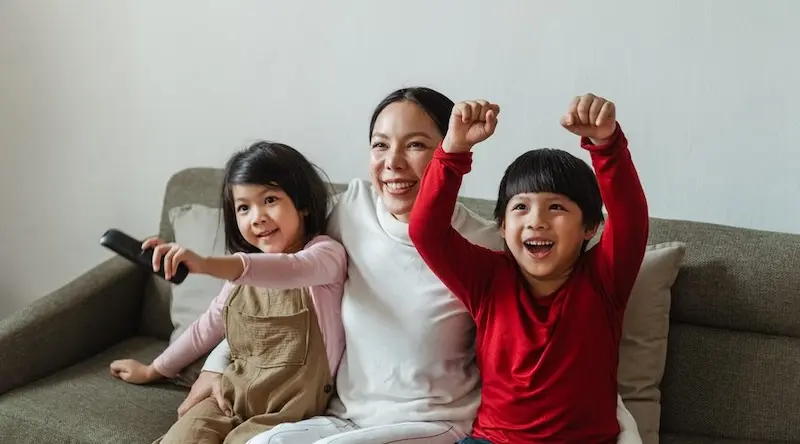settings
children
With Famly since
Whether we like it or not, we’re getting more screen time than ever. In fact, we’re raising our average daily screen time faster than researchers can tell us to cut it out.
But as long as we’re here, we may as well make sure we’re using that screen time in the best way possible — and that’s more important for young children than for anyone else.
Children absorb all sorts of tiny details and social nuances from their TV shows, and use those cues as models for their real-life behavior. But to us grown-ups, these details can seem so small and insignificant, that most of us might not know what to look out for.
So what really makes a good children’s TV show?
To unpack that, I called up Dr. Colleen Russo Johnson. Colleen is a researcher and developmental psychologist, with a special focus on children’s media and technology. She’s a senior fellow with the UCLA Centers for Scholars and Storytellers, and the Chief Scientist and co-founder of the OK Company, makers of the OK Play app. We talked about why it’s so critical we pay attention to what TV shows children are watching, and how we can help children get the most out of their screen time.
Let’s tune in.
Why you need to care about what shows children watch
It’s tempting to just let children watch whatever they want. But according to Colleen, it’s really important that we give it more thought. With young children, she explains, the fine details of what they’re watching matter more than ever.
“85 percent of our brain development occurs in our first five years. Young children are sponges, soaking up everything they see and hear. They’re so, so influenced by what they’re watching — more so than they’ll be at any other point in their lives,” Colleen says.
It’s much more than just teaching them about shapes and numbers. Children’s TV shows are a great way to introduce little ones to life lessons, social and emotional concepts, and big ideas that they’ll use their whole lives. But there’s a lot of nuance that shapes exactly what children take away from their screen time.
That’s why it matters that we pick carefully.
The big ideas
Top tips for responsible screen time
If you’ve only got a minute, here’s what you should know about helping children get the most out of their screen time.
- Watch with your child, whenever possible. When adults watch along with children and talk about what’s going on, research shows a big jump in children’s engagement and learning. Even listening in from the other room and asking the occasional question is helpful, too.
- Pre-select the options that children can access. As much as you can, do a bit of browsing to make sure children can only access shows that are healthy, thoughtful and well-produced. That way, you’ll feel better if you do need to leave them alone as they watch.
- Look for shows that are slower, simpler and calmer. These types of programs are easier for young children to follow and reflect on. Programs that are too flashy and noisy are appealing to children, but can be distracting.
- Limit screen time for children under age two. Very young children have a hard time understanding that the things on the screen represent real life. It’s best to keep them engaged with toys and real-life interaction.
- Stay away from YouTube. Children’s use of YouTube is on the rise, but we’ve got to be careful. Privacy concerns, the risk of disturbing content, and a lack of accountability mean that YouTube can be an unsafe place for young children.
- Focus more on what children are watching, not how much. Like it or not, we’re all using screens way more than normal right now. It’s best to put our efforts into making sure children are using those screens in a way that’s healthy, safe and productive.
What makes a good children’s TV show?
As it turns out, a good children’s TV show doesn’t need to be educational. At least, not in the traditional sense.
Children absorb so many different layers of learning from television — from big things like the concrete lessons in an episode, to little things like the tone in which characters talk to each other. Because of this, those small details in how children’s shows are written and presented can have big effects on what children learn from it.
In deciding what shows are best for your children, it might help to ask these questions:
- How is the show paced? Slower, calmer shows are easier to follow, and give children more time to reflect about what they’re seeing. Loud, colorful, fast-paced shows are exciting for children, but they can become conditioned to this sort of overstimulation.
- Does it encourage curiosity? Does the show encourage children to actively explore and engage with the world around them, rather than just passively receiving information?
- How do the characters treat each other? A good show presents positive, realistic examples of how we handle problem solving and negotiations in our personal relationships.
- Are the “bad characters” clear to children? Think about Oscar the Grouch from Sesame Street, or Gargamel from The Smurfs. It’s very clear to children that these are not good role models, so they shouldn’t follow their behavior.
- Does it reflect diverse identities? Children’s shows should represent people of all backgrounds and identities in a positive light.
- Are negative scenarios quickly and clearly resolved? If shows focus too much on the problem, and not how to solve it, children might learn more about causing problems, not problem-solving.

Helping children get the most out of their screen time
Here are some of Colleen’s top tips for making sure children’s screen time is as healthy and productive as possible:
Watch with them. The gold standard for children’s screen time is watching along with a parent, Colleen says. Children’s learning, engagement and understanding all get a big boost when they watch along with an adult caregiver.
“This way, children have the opportunity to pause, ask questions about the show, and compare it to real life. The show can prompt deep, rich conversations — much in the same way that you’d talk when reading a book to a child,” Colleen says.
Even if you can’t watch alongside your children, checking in from the other room is still beneficial for them. Just lend half an ear — chime in with the occasional, “Ooh, what’s happening now?”
Focus on the social and emotional learning. Every children’s TV show sets out to be educational, but it matters what they’re trying to teach. For Colleen, it’s most important that the shows set good examples of how to treat one another, and how to be a curious, thoughtful, considerate person.
“Every child is going to learn their ABCs and colors eventually. It’s much more complex and important to learn social and emotional skills, so that’s a priority for any quality show,” she says.
Pick their options ahead of time. Colleen recommends that with any streaming platform, children should not have full reign over what they’re choosing to watch.
“Even if a platform has a designated children’s section, you should always have parents or caregivers as a filter,” Colleen says. “If children are browsing through shows, you should sit with them and browse along. See what imagery, themes and characters they like. Watch some episodes with them, and decide whether it’s right or not.”
Putting a streaming device on airplane mode and offering children a selection of pre-downloaded TV shows is an easy, safe way of making sure they’ve got a carefully curated selection. This way, you’ll be more comfortable if you have to leave them alone as they watch.

The trouble with YouTube
YouTube has eclipsed traditional television as the go-to place for children’s TV shows. That’s cause for concern.
Here’s why you should think twice about leaving your child to browse freely on YouTube:
- YouTube isn’t regulated like broadcast TV. Traditional broadcasters have to follow a whole host of rules about what they can show, especially for children’s channels and networks. YouTube’s content creators, as well as the platform itself, don’t have that same responsibility.
- Children can easily come across disturbing content. Partially because of this lack of regulation, YouTube’s “watch next” algorithm has a worrying tendency to lead children toward inappropriate and disturbing content.
- YouTube has a bad history with data privacy. In 2017, the US Federal Trade Commission fined YouTube $170 million to settle charges that it illegally collected children’s browsing data, in order to serve them tailored advertisements.
What if you just find the show annoying?
Even if you’re sick of hearing the Paw Patrol theme song for the fourteenth time today, Colleen recommends you hold back your instinct to reach for the headphones. It’s important that you’re always able to listen in on what children are watching.
But given the wealth of good programming out there, you can find something else that both you and your child can agree on. And if you’re finding a certain show irritating, it might be a red flag that it’s time to find another children’s TV show to watch.
“What exactly is it that’s annoying? Is it the way a character talks, or how they treat someone else? TV is a huge influence for modeling behavior to children,” Colleen says. “So if there is some behavior on the show that you think is irritating, there’s a high chance children will start to imitate it. Especially right now, you don’t need to make your life harder than it needs to be.”
Where you can go for the best shows
There’s no shortage of “Top 10” lists for children’s shows all over the internet. But at the end of the day, you know your child best. You should pick shows that encourage children’s curiosities, that dive into the subjects and narratives they like best.
When it comes to deciding whether a given show is age-appropriate, Colleen recommends referring to Common Sense Media. Intended for both parents and educators, it offers reviews of thousands of movies, shows and games for children aged 0 through 17, and gives you an idea of what sort of themes and content you can expect.
As Colleen explains, finding a good children’s TV show ahead of time translates to more peace of mind for parents about their child’s screen time later on.
“As a working mom of two kids, I get it. It can be really, really hard to feel comfortable with their children’s screen time. But I want parents to know the responsibility is on the content creators to make that screen time valuable, productive and healthy,” she says. “Especially for social and emotional development, there’s a lot we can do at home — and children’s media is a big part of that.”
Get 1000s of free EY activities
Want over 7,000 activities? See them in a free 14-day trial. Filter to target learning areas, age groups and topics, and get inspired.
Get started









